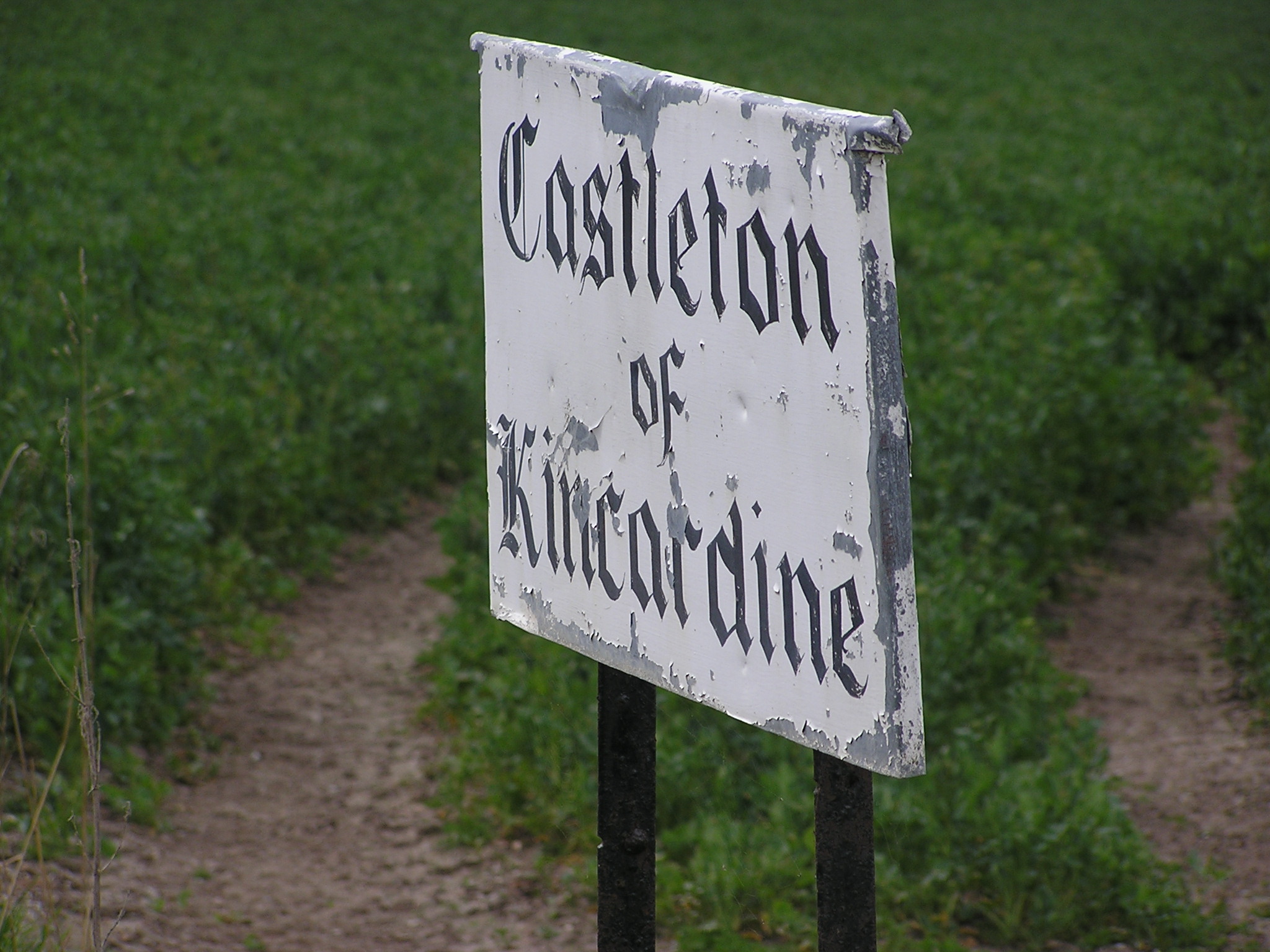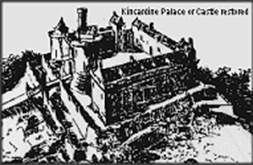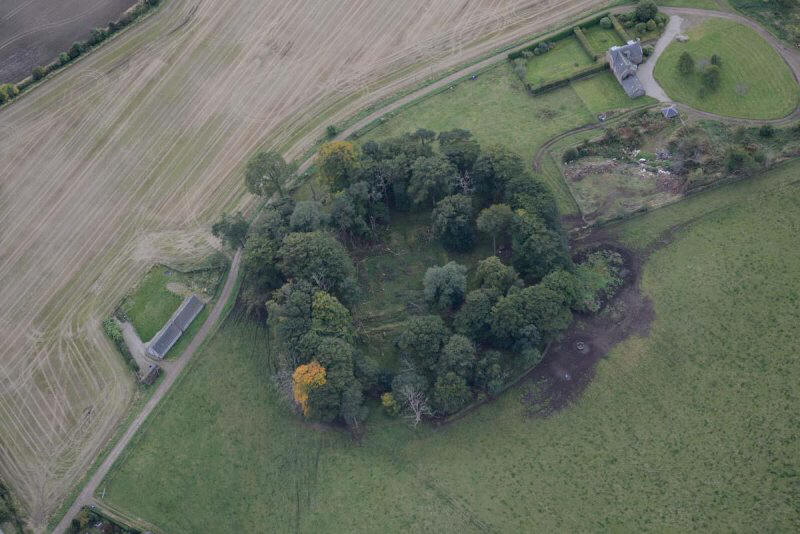Castleton of Kincardine, Mearns
Castleton of Kincardine

The old castle of Kincardine is located in Kincardineshire and near between Fettercairn and Lawrencekirk, and only a few miles from Thornton Castle. This site should not be confused with Kincardine Castle in Kincardine O'Neill, or Auchterarder.
Kincardine Castle first appears on record in 1212, but then vanishes from records until after the English occupation of the 1290s, at which point it was almost certainly destroyed, although no record relates to this. The castle and lands were granted away by Robert the Bruce and King David II, and were later the property of the Earls of Ross. The castle itself was probably abandoned by the earls and fell into disrepair after the Lords of the Isles, claiming the earldom of Ross, were suppressed in the mid 15th century. The castle and borough have not benefitted from systematic archaeology, making the latter history rather opaque. The county was created in 1532 by the Earl Marischal, but the castle was no longer in use by that time, and the borough declined with the last occupancy being the late 18th century.
Kincardine Castle was a Royal Castle, which was at times the residence of King William I (the Lion). During the War of Scottish Independence, King John Balliol refused to submit to King Edward I of England, whom the Scottish Guardians foolishly appointed Lord Paramount of Scotland. Instead, King John I formed a mutual defense alliance with France. The English quickly invaded Scotland, and after two brutal Scots defeats at Berwick Upon Tweed and later Dunbar, the King drafted a letter of surrender at Kincardine Castle.

John Strachan of Thornton was Receiver on behalf of the Crown of the thanage rents of Kincardine, Fettercairn, and Aberluthnot from 1460-1466.John obtained the lands of two Kincardine Castle parks and other lands from King James II (Bonnet Lairds, pp 34).
According to Bonnet Lairds, the Strachans of Thornton had sold Kincardine Castle before 1646. We know this for certain, as Alexander Strachan of Thornton made a strong case to the government to reimburse the estate for prior fortifications made to Thornton Castle to defend it against Montrose's Royalist forces garrisoned in nearby Kincardine Castle. In 1646, he petitioned the Estates of Parliament:
[1645/11/278] REFERENCE for Alexander Strachan of Thornton 4 FEB 1646
The estates of parliament, having taken into their consideration the supplication of Alexander Strachan of Thornton, desiring that order might be given to cause deliver provision of arms, ammunition and victual for 30 men for keeping his house of [...] against the rebels for the good of the service and benefit of the country nearest adjacent thereto, which the supplicant obliges himself shall be kept for the use and service of the country; and also desiring that he may have some consideration for his bygone care and expenses in fortifying and keeping out the said house against the rebels to the benefit of the country thereabouts, as the supplication bears; the said estates do hereby seriously remit and recommend the supplicant, with his supplication and desire thereof aforesaid, to the committee of estates, that they may take such course concerning the aforesaid desires for the supplicant's satisfaction relating thereto as they shall think fit.
Parliament received this petition favourably and recommended the supplication of the Committee of the Estates. /p>
[1645/11/277] REFERENCE for Lieutenant.Colonel Strachan. 4 FEB 1646
The estates of parliament, having heard and considered the report of that committee appointed for [pan class="reg">Alexander Lindsay], lord Balcarres' business concerning the sufferings and deservings of Alexander Strachan of Thornton, lieutenant colonel to the Lord Balcarres' regiment, and of Captain William Cockburn, rutmaster there, they remit and recommend the said lieutenant colonel and rutmaster, with their sufferings and deservings, to the committee of estates, to be taken into consideration by that committee for their satisfaction as the committee shall think fit.
The petition was granted, and Thornton received reimbursement, arms, ammunition, and sustenance for 30 soldiers for defense of the Thornton Castle from the forces on Montrose garrisoned in nearby Kincardine Castle.
The old castle of Kincardine is located in Kincardineshire and near between Fettercairn and Lawrencekirk, and only a few miles from Thornton Castle. It is only a pile of masonry now atop a lonely farmland hillock but at one time Kincardine Castle was so mighty that it gave its name to a whole county, as it was a very important and royal castle.
The spot had strategic importance since it guarded the twisting Cairn o' Mount pass leading over to Banchory and Deeside. A Pictish fort, known picturesquely as the Green Castle, had been the predecessor of the much formidable stronghold that replaced it with towering battlements, spacious courtyards and a splendid banqueting hall.
It was to this powerful castle that King Kenneth II traveled as a guest of the Thane of Angus in 995. Kenneth, the ruler of Alba (once the Gaelic name for Scotland or 'the land beyond the Roman wall') which had been created by his forefather Kenneth McAlpine through moulding together a federation of the Picts and the Scots, had been on his throne for 24 years,
Kenneth III had gone on a pilgrimage to the grave of Palladius, whose bones by this time had acquired a wonderful repute for sanctity, and whose tomb had become a famous resort of pilgrimage. After performing his devotions at the shrine of the saint, the king turned aside to visit the castle of Fettercairn, of which Finella, a sort of Scottish Heroedias, was mistress.
Lady Finella owed the king a grudge for hanging her son Crathilinth for the crime of making to free with the king's laws and the lives of his subjects. Thus, she took care that the king should not leave her castle alive.
Although there is no doubt Finella is responsible for the murder of Kenneth II, there is some controversy as to the deed itself.
One story has it, that the king was sent away with every token of good will, but that he was slain by horsemen who lay in ambush for him on the road.
Another, and more interesting tale, is that she had prepared an "infernal machine" which consisted of a brass statue, which threw out arrows when a golden apple was taken from its hand. It stood in a handsome apartment, surrounded by rich drapery and curious sculptures. Under pretext of amusing the king with this curiosity, she conducted him to the apartment, and courteously invited him to take the apple. The king, amused with the idea, picked up the apple, when instantly he was pierced with arrows and mortally wounded. The attendants, on coming for their royal master, could not gain admittance to the castle, from whence the assassin had already fled (Finela fled to St. Cyrus where, in what has since become known as the Den of Finella, she was done to death). However, they forced open the doors, and found to their horror and consternation the king weltering in his blood. So much for a woman's vengeance. His death occurred in A.D. 995, and the twenty-fifth of his reign.
It seems that a small township grew up round the castle (which was used by Queen Mary in 1560), but in 1600 Stonehaven became the county town and both Kincardine town and castle fell into decline. The mercat cross was transferred to Fettercairn in 1730, and nothing now remains of old Kincardine town and little more of the castle.

Sources:
• Canmore ID# 121171
• Grampian Ways: Journey over the Mounth